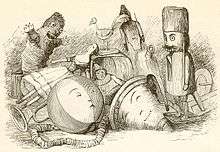The Sweethearts; or, The Top and the Ball
| "The Sweethearts; or, The Top and the Ball" | |
|---|---|
|
Andersen in 1836 | |
| Author | Hans Christian Andersen |
| Original title | "Kjærestefolkene [Toppen og bolden]" |
| Country | Denmark |
| Language | Danish |
| Genre(s) | Literary fairy tale |
| Published in | New Fairy Tales. First Volume. First Collection. 1844. (Nye Eventyr. Første Bind. Første Samling. 1844.) |
| Publication type | Fairy tale collection |
| Publisher | C.A. Reitzel |
| Media type | |
| Publication date | 11 November 1843 |
| Preceded by | "The Nightingale" |
| Followed by | "The Ugly Duckling" |
"The Sweethearts; or, The Top and the Ball" (Danish: Kjærestefolkene [Toppen og bolden]) is a literary fairy tale by Hans Christian Andersen about the unrequited love a mahogany top suffers for a leather ball. It is likely the tale's inspiration lies in Andersen’s youthful relationship with Riborg Voight, a woman who declined his marriage proposal in 1830. "The Sweethearts" was published by C.A. Reitzel in Copenhagen in November 1843 with several other tales by Andersen in the book New Fairy Tales. The collection was received by Danish critics and the public with great acclaim.
Plot
In a drawer filled with playthings, a mahogany top woos a leather ball. The ball spurns the top, thinking she deserves a finer suitor. One day, the ball is taken outdoors, thrown high into the air, and disappears. The ball has landed in the roof gutter but the top believes she has become the wife of a swallow living in a nearby tree. Not being able to possess her, the top's infatuation deepens. Years pass, and, one day, the top is refurbished with gilding. He is spun and jumps into the dust bin. Among the trash lying about, he sees the ball who has suffered much from exposure to the elements. She doesn't recognize him as her former suitor and tells him she spent five years in the roof gutter soaked with rain before falling into the dustbin. The maid suddenly arrives, finds the top, and carries him into the house. The top puts aside the passion he felt for the ball, "for love vanishes when one's sweetheart has been soaking in a gutter for five years. You don't even recognize her when you meet her in a dustbin."
Background
"The Sweethearts" is original with Andersen and owes no debt to traditional folk or fairy material. The tale's inspiration is likely found in Andersen’s relationship with Riborg Voight, the daughter of a Danish merchant who declined his marriage proposal in 1830. Following her rejection, Andersen slipped into a deep depression. He questioned both his artistic abilities and his sexuality. He needed to get away from Denmark and planned a trip to Germany – his first excursion abroad. Andersen met Voight again in 1843 while on holiday on Funen and discovered she had become a frumpy, middle-aged matron.[1]
Publication history

"The Sweethearts" was third in a volume of four tales that consisted of "The Angel", "The Nightingale", and "The Ugly Duckling" as the final tale.[2] The volume was published in Copenhagen on 11 November 1843 by C. A. Reitzel as New Fairy Tales. First Volume. First Collection. 1844.. For the first time the phrase "told for children" was not part of the title—an omission Andersen scholar and biographer Jackie Wullschlager believes exhibited a new confidence on Andersen's part: "These were the most mature and perfectly constructed tales he had written, and though some of them at once became, and have remained favorites of children, Andersen here melds together the childlike and the profound with exceptional artistry." The first edition of 850 was sold out by December 18, and Reitzel planned the publication of another 850.[1] "The Sweethearts" was republished 18 December 1849 in Fairy Tales and again on 15 December 1862 in Fairy Tales and Stories.[2]
Reception

Wullschlager observes that New Fairy Tales was a break-through for Andersen who, until its publication, had generally received vigorous condemnation from the Danish critics for his venture into the fairy tale genre. Reviews for the collection however were ecstatic, she notes. Ny Portefeuille wrote, "There is in these tales so much beauty and goodness, so much humour and seriousness, so much poetry and depth, that even the most disparate readers will by necessity find something of interest to them." Andersen wrote his confidante Henriette Wulff, "These tales have been received with unanimous applause. None of my other books have had such a success here at home, every paper commends them, everyone reads them [...] I am appreciated as the best fairy-tale teller."[1][3]
Andersen scholar and biographer Jackie Wullschlager views "The Sweethearts" as "a spare, sarcastic little tale". Like other Andersen tales, its "triumphant conclusion is offset by a pathos of tone." Unlike the traditional happily-ever-after marriage finales of fairy tales, Wullschlager notes, "The Sweethearts" ends with the Top (like his creator) going through life alone. Published with "The Nightingale"—a tale whose inspiration lay in Andersen’s budding infatuation for the Swedish singer Jenny Lind—Wullschlager suggests Andersen may have viewed the two tales as complementary: one, the “valediction of an old love affair and the other, the celebration of a new one.”[4]
Notes
References
- Andersen, Jens (2005). Hans Christian Andersen: A New Life. Overlook Duckworth. ISBN 1-58567-737-X.
- "Hans Christian Andersen: The Sweethearts; or, The Top and the Ball". Retrieved 2009-04-21.
- Wullschlager, Jackie (2000). Hans Christian Andersen: The Life of a Storyteller. University of Chicago Press. ISBN 0-226-91747-9.
External links
- "The Sweethearts" English translation by Jean Hersholt
- Kjærestefolkene Original Danish text

